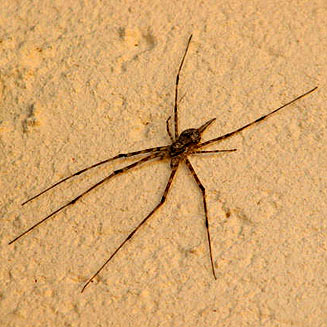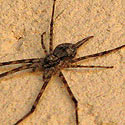|
Family: Hersiliidae (Long-spinnered or two-tailed spiders) Life
> Eukaryotes
>
Opisthokonta >
Metazoa
(animals) > Bilateria > Ecdysozoa > Panarthropoda > Tritocerebra >
Arthropoda > Arachnomorpha > Cheliceriformes > Chelicerata > Euchelicerata
> Arachnida > Araneae
> Araneomorpha
 |
|
|
Hersilia sp. Submitted to Biodiversity
Explorer for identification by Miles Clarke. |
|
Have distinctive elongate lateral spinnerets, which are used
in prey capture by swaying them over the victim thus wrapping the victim in
silk. Two genera in southern Africa: Hersilia is usually found in trees
and Tyrotama is usually found under rocks.
The Hersiliidae is a family of spiders noted for their
elongated posterior lateral spinnerets which can be as long as the abdomen in
long-spinnered bark spiders and less in rock living species. Hersiliids are
small to medium (4.5-12.5mm body length) dorso-ventrally flattened spiders,
especially the arboreal genera. They are cryptically coloured in variegated
shades of cream, orange, green, brown, grey and black, features they share with
the family Selenopidae. Both families are quick and difficult to capture as they
disappear into the narrowest of crevices.
As viewed from above, the carapace is oval with the 8 eyes
situated in two recurved rows, on a raised hump or tubercle. The anterior
median eyes are largest. The oval abdomen is wider posteriorly with the
posterior lateral spinnerets extending out parallel to each other. The inner
edge of these spinnerets is lined with silk-producing tubules (spine-like
spigots) as opposed to the distally placed spigots of most spiders. The
rupicolus genera have shorter spinnerets that are often not seen as they are
curled up against the abdomen and the legs are shorter.
Hersilia
Genera indigenous to southern Africa
Hersilia
Hersilia is a diurnal, arboreal genus which can sometimes be found on nearby
rocks. They do not spin webs or construct retreats and can often be spotted
only by the reflection of the sun on their dragline silk threads. They
capture cursorial prey by swaying their long spinnerets over the victim and
encircling it wrapping more silk over it. The prey is then bitten and
consumed on the spot. The egg sac is wrapped in silk with bits of bark
debris attached to aid camouflage. |
 |
Tyrotama
Tyrotama is a small to medium (4.8-9.5mm body length) rupicolus genus
endemic to South Africa, Namibia and Angola. This genus was until recently
known as Tama. They occur in rocky or mountainous areas under stone
on rock. They attach themselves under the stone where they construct a
circular “kraal” retreat with silk trip lines radiating from it. This “kraal
and its egg sac is constructed from silk with embedded sand particles. The
prey is caught in the same fashion as the genus Hersilia but is taken
to the retreat to be consumed. |
|
|
